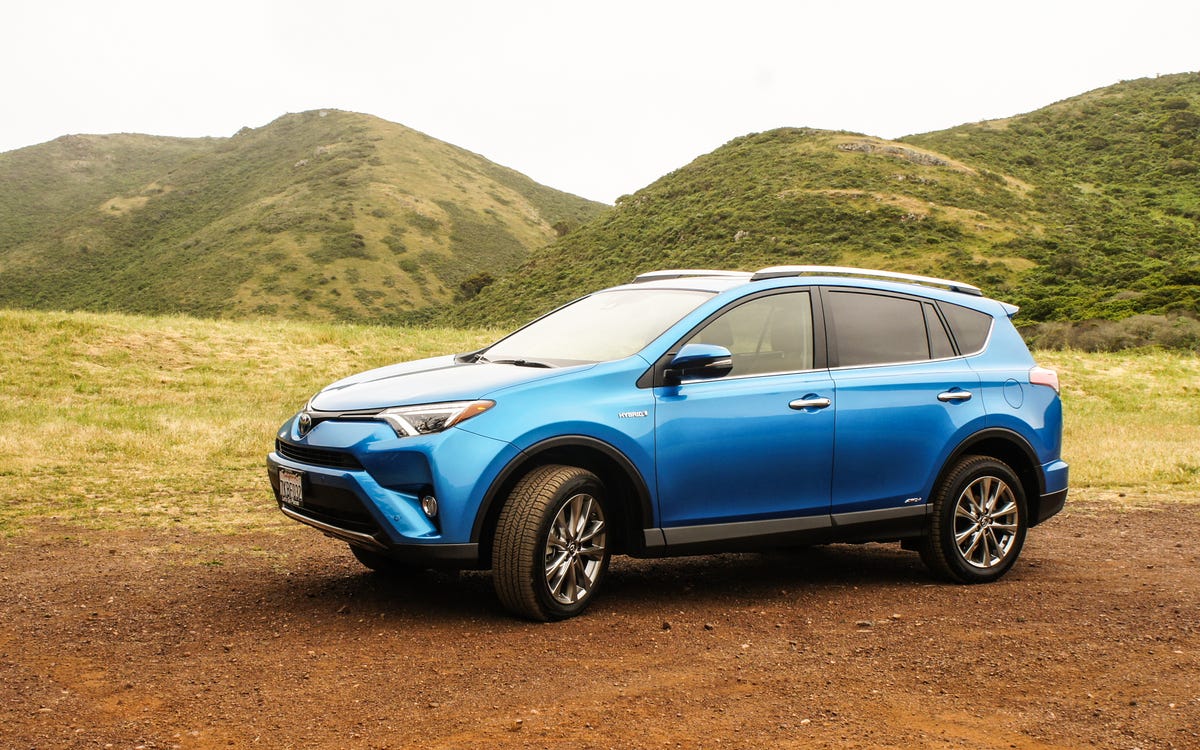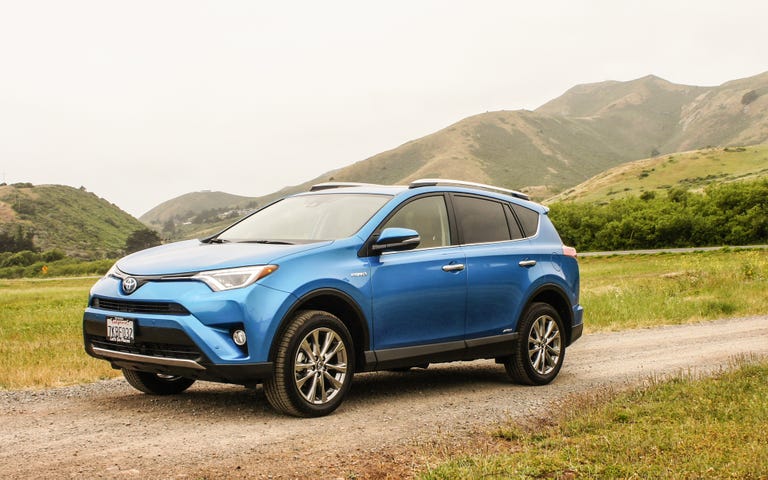 Why You Can Trust CNET
Why You Can Trust CNET 2016 Toyota RAV4 Hybrid review: Utility, comfort and economy make the RAV4 Hybrid an all-around star
Toyota combines its very economical hybrid drive system with standard all-wheel drive in its smart little crossover.
For many drivers, small SUVs make for a perfect everyday vehicle, economical enough for commuting and offering more useful cargo space than midsize sedans, extending their use for weekend recreation. In fact, sales figures back up the rise of the small SUV on US roads, with Ford noting its Escape model as its second best selling vehicle.
The Good
The Bad
The Bottom Line
Entering the scene in 1994, Toyota's RAV4 pioneered its segment. Now this small SUV gets Toyota's ultra-efficient hybrid drive system, making it a killer everyday vehicle. Consider its standard all-wheel drive, and you've just about hit perfection.
Although it isn't a serious off-roader, I was impressed by the lifted nose of the 2016 Toyota RAV4 Hybrid, although faux skid plates under front and back are a bit much. The sides of the RAV4 Hybrid show similar sculpting to its bigger brother, the Highlander, but the narrow grille looks petite by comparison. Saddle-brown leather seating, in this Limited trim RAV4 Hybrid, gave the cabin luxury style.

Standard all-wheel-drive and fuel economy averaging above 30 mpg makes the RAV4 Hybrid a car for city and country.
Camry traits
Although the RAV4 Hybrid uses the same engine as the Camry Hybrid, a 2.5-liter four-cylinder, it gets a more complicated hybrid drive system, adding a second drive motor to the rear wheels for all-wheel drive. And that comes standard.
Otherwise, the RAV4 Hybrid uses the same 245-volt nickel-metal hydride battery pack as the Camry Hybrid, a little less sophisticated than the lithium ion battery pack in the new Prius. Toyota notes the overall drive system output of 194 horsepower and 206 pound-feet of torque for the RAV4 Hybrid, and fuel economy of 34 mpg city and 31 mpg highway. The hilly roads of San Francisco and its environs took a toll on my mileage, as I didn't break 30 mpg until I drove a an hour on a flat highway.
As with other hybrids in the Toyota stable, the RAV4 Hybrid mixed its engine and motor power seamlessly as I drove. The car rewarded gentle throttle pressure with an EV icon lighting up on the instrument cluster, meaning it had entered electric drive mode, although the nearly 4,000 pound curb weight of the car made that lighted icon a rare occurrence when taking off from a stop.
More frequently I would see that icon light up when I held a steady pace on a flat road. On hill descents I was gratified by the needle on the RAV4 Hybrid's power gauge entering the charge zone, as regenerative braking recharged the car's battery and minimized wear on brake pads.
The RAV4 Hybrid also features driver-selectable sport, eco and EV modes, the first two sharpening or detuning the throttle. I'm not a fan of drive modes in a car like this, but they can serve to customize the car's response for different drivers. EV mode drives the car under electricity only for as long as the battery can hold out, but even on a full charge that won't be much more than a mile.
The lifted nose looks good on the RAV4 Hybrid, and would benefit approach angles if this car were a real offroader.
Comfort and quiet
Over some bumpy roads, the RAV4 Hybrid could feel a little bouncy, but most of the time the suspension delivered a very competent ride. While short of luxury, it felt very comfortable on most road surfaces, complementing its smooth ride with minimal road noise. Given the hybrid drivetrain, I rarely heard any engine noise.
Adding to the RAV4 Hybrid's suitability for long highway trips, its electric power steering left a little play at center, a comfort zone where I needn't constantly be adjusting input. When actually in a turn, the wheel assumed a more responsive character.
That steering is tied to a lane keeping assist function, standard with the RAV4 Hybrid's Limited trim, actively preventing lane drift. Trying out the system on the freeway, I found its programming very conservative. Rather than keeping the car center in its lane, as with more aggressive systems, it only stepped in once my wheels were running over the lane lines. And when I kept a loose grasp on the wheel to allow lane drift, the car very quickly warned me to take a stronger hold on the steering.
Toyota tunes the RAV4 Hybrid's steering and suspension for comfortably everyday driving.
Adaptive cruise control operated very smoothly at speed, not reacting too abruptly when a car cut in front of me. However, this system cut out when traffic speeds dropped below 5 mph. I had to handle brake and throttle work myself in stop-and-go traffic.
Energy illustrated
Centered in the dashboard, Toyota's navigation and Entune app integration showed up on a 7-inch touchscreen. That screen size is a bit small, especially as competitors such as the Ford Escape gets an 8-inch screen. And Toyota's system doesn't support Apple CarPlay or Android Auto, features that could be a deal breaker for some buyers.
However, this head unit included detailed fuel economy and energy use screens for the RAV4 Hybrid's drivetrain, including a real-time drivetrain animation showing engine and motors.
As with other Toyota hybrids, you can see when engine and motors are active on the RAV4 Hybrid's dashboard LCD.
Relying on Toyota's navigation for turn-by-turn routing, the system didn't try very hard to keep me out of traffic jams. And when I got off-route, it took an inordinately long time to recalculate, which would prove frustrating in a strange city. Overall, this navigation system is unsophisticated and behind-the-times.
As a saving grace, Toyota Entune Apps integrate third-party apps such as Yelp, Pandora and Movietickets.com, along with an unbranded online destination search. To enable these apps, I had to run the Entune app on my phone, and either pair it with or cable it to the RAV4 Hybrid. Online search particularly impressed me in that, instead of merely matching my search terms to business names, it matched those terms to business descriptions as well, leading to more relevance and depth of search results.
Along with a few music apps, the RAV4 Hybrid's stereo features the usual digital sources, including satellite and HD radio, a USB port and Bluetooth streaming.
Unique among small SUVs
The dearth of hybrids among small SUVs is surprising, especially as hybrid drivetrains are so common among midsize sedans, segments that can easily be cross-shopped. Ford canceled its Escape Hybrid, and electric drive hasn't found its way into the Honda CR-V, Nissan Rogue or Kia Sportage, to name a few in the segment.
The success of the 2016 Toyota RAV4 Hybrid could change the segment, encouraging other automakers to extend their hybrid offerings to small SUVs.
With the only full hybrid drive system among small SUVs, the RAV4 Hybrid achieves much better fuel economy than any in its segment.
Certainly drivers of the RAV4 Hybrid will be pleased by their fuel economy, the car's comfort and its general utility. All-wheel drive should inspire confidence in areas with wintry weather, and the RAV4 Hybrid can serve a wider range of uses than a midsize sedan.
Following Toyota's often conservative nature, tech features such as driver assistance systems and dashboard electronics don't push many boundaries. The lack of sophistication here could push buyers towards the competition, but the hybrid drivetrain is an undeniably unique advantage.
Price will put the the 2016 RAV4 Hybrid out of reach for some, as it goes for $28,370 in base XLE trim. However, that's only $2,000 more than the standard RAV4 XLE, and the hybrid comes better equipped. The RAV4 Hybrid Limited, which I drove, hits the mid-30s for price, but that also comes with navigation and driver assistance features, and substantially better fuel economy than its gasoline-only counterpart.


